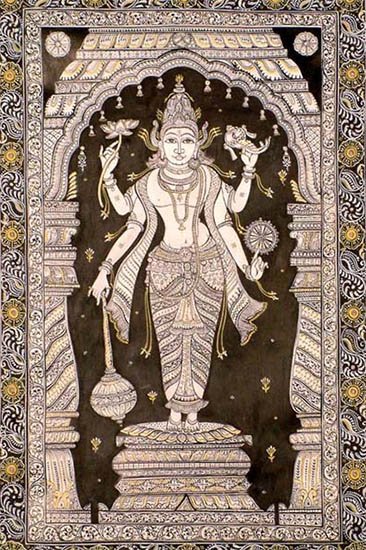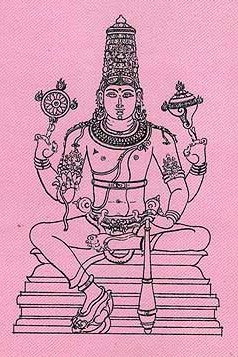Ahirbudhnya: 11 definitions
Introduction:
Ahirbudhnya means something in Hinduism, Sanskrit. If you want to know the exact meaning, history, etymology or English translation of this term then check out the descriptions on this page. Add your comment or reference to a book if you want to contribute to this summary article.
In Hinduism
Shilpashastra (iconography)
Source: Wisdom Library: Elements of Hindu Iconograpy1) Ahirbudhnya (अहिर्बुध्न्य):—Third of the eleven emanations of Rudra (ekādaśa-rudra), according to the Viśvakarma-śilpa. He keeps in his right hands the gadā, chakra, khaḍga, ḍamaru, mudhara, śūla, aṅkuśa and akṣamālā; and in the left hands the tomara (an iron club), paṭṭiśa, kavacha (shield), kapāla, tarjanī, ghaṭa, śakti and paraśu; or, there may be in one of the left hands a sword as in the right hand.
2) Ahirbudhnya (अहिर्बुध्न्य):—Ninth of the twelve emanations of Rudra, according to the Rūpamaṇḍana.

Shilpashastra (शिल्पशास्त्र, śilpaśāstra) represents the ancient Indian science (shastra) of creative arts (shilpa) such as sculpture, iconography and painting. Closely related to Vastushastra (architecture), they often share the same literature.
Pancaratra (worship of Nārāyaṇa)
Source: Hindupedia: Ahirbudhnya Saṃhita1) ‘Ahirbudhnya’ is one who, in the form of an ‘ahi’ or serpent, is the ‘budhna’ or foundation of the world. So, literally it refers to Śeśa or Ananta, the thousand-hooded Serpent, on whose head the whole world is said to be supported, according to some of the purāṇas.
2) Ahirbudhnya is also mentioned as one of the names of Śiva who, according to the Vaiṣṇava scriptures, is a great devotee of Viṣṇu. In the Ahirbudhnya Saṃhitā work he is identified with Śiva. ‘Saṃhitā’ is a general name given to any systematically arranged text.
Source: Shodhganga: Iconographical representations of Śiva (pancaratra)Ahirbudhnya (अहिर्बुध्न्य) or Ahirbudhnyasaṃhitā is the name of a Vaiṣṇava Āgama scripture, classified as a sāttvika type of the Muniprokta group of Pāñcarātra Āgamas. The vaiṣṇavāgamas represent one of the three classes of āgamas (traditionally communicated wisdom).—Texts of the Pāñcara Āgamas are divided in to two sects. It is believed that Lord Vāsudeva revealed the first group of texts which are called Divya and the next group is called Muniprokta which are further divided in to three viz. a. Sāttvika (e.g., Ahirbudhnya-saṃhitā). b. Rājasa. c. Tāmasa.

Pancaratra (पाञ्चरात्र, pāñcarātra) represents a tradition of Hinduism where Narayana is revered and worshipped. Closeley related to Vaishnavism, the Pancaratra literature includes various Agamas and tantras incorporating many Vaishnava philosophies.
Purana and Itihasa (epic history)
Source: archive.org: Puranic EncyclopediaAhirbudhnya (अहिर्बुध्न्य).—One of the sons of Viśvakarmā. Five sons and one daughter were born to Viśvakarmā of his wife Surabhī. They were Ajaikapāt, Ahirbudhnya, Tvaṣṭā, Rudra, Barhiṣmatī and Saṃjñā. (See under genealogy of Viśvakarmā).
Source: Cologne Digital Sanskrit Dictionaries: The Purana IndexAhirbudhnya (अहिर्बुध्न्य).—A Rudra, and son of Bhūta and Sarūpā.*
- * Bhāgavata-purāṇa VI. 6. 18; Brahmāṇḍa-purāṇa III. 3. 71; Matsya-purāṇa 5. 29, 32; 171. 39; Vāyu-purāṇa 66. 69.
Ahirbudhnya (अहिर्बुध्न्य) is a name mentioned in the Mahābhārata (cf. I.60.2) and represents one of the many proper names used for people and places. Note: The Mahābhārata (mentioning Ahirbudhnya) is a Sanskrit epic poem consisting of 100,000 ślokas (metrical verses) and is over 2000 years old.

The Purana (पुराण, purāṇas) refers to Sanskrit literature preserving ancient India’s vast cultural history, including historical legends, religious ceremonies, various arts and sciences. The eighteen mahapuranas total over 400,000 shlokas (metrical couplets) and date to at least several centuries BCE.
Jyotisha (astronomy and astrology)
Source: Wisdom Library: Brihat Samhita by Varahamihira1) Ahirbudhnya (अहिर्बुध्न्य) is the presiding deity of Uttaraproṣṭhapadā, according to the Bṛhatsaṃhitā (chapter 8), an encyclopedic Sanskrit work written by Varāhamihira mainly focusing on the science of ancient Indian astronomy astronomy (Jyotiṣa).—Accordingly, “The twelve yugas of Jupiter’s cycle are known as belonging to the Devas 1. Viṣṇu, 2. Jupiter, 3. Indra, 4. Agni (fire), 5. Tvaṣṭā, 6. Ahirbudhnya [i.e., Uttaraproṣṭhapadā], 7. The Pitṛs, 8. Vāsudeva, 9. Soma (the Moon), 10. Indrāgni, 11. Aśvinideva, 12. Bhaga (the Sun)”.
2) Āhirbudhnya (आहिर्बुध्न्य) is another name for Uttarabhādrapada , according to the Bṛhatsaṃhitā (chapter 15) (“On the nakṣatras—‘asterisms’”).—Accordingly, “Those who are born on the lunar day of Uttarabhādrapada [i.e., āhirbudhnya] will be Brāhmins, performers of sacrificial rights; will be generous, devout, rich and observant of the rules of the holy orders; will be heretics, rulers, dealers in rice”.

Jyotisha (ज्योतिष, jyotiṣa or jyotish) refers to ‘astronomy’ or “Vedic astrology” and represents the fifth of the six Vedangas (additional sciences to be studied along with the Vedas). Jyotisha concerns itself with the study and prediction of the movements of celestial bodies, in order to calculate the auspicious time for rituals and ceremonies.
Languages of India and abroad
Sanskrit dictionary
Source: Cologne Digital Sanskrit Dictionaries: Cappeller Sanskrit-English DictionaryĀhirbudhnya (आहिर्बुध्न्य).—[masculine] [neuter] [Epithet] of a lunar mansion.
Source: Cologne Digital Sanskrit Dictionaries: Monier-Williams Sanskrit-English Dictionary1) Ahirbudhnya (अहिर्बुध्न्य):—[=ahir-budhnya] [from ahi] a m. (considered as one word and therefore declinable as follows [dative case] ahir-budhnyāya, [Pāraskara-gṛhya-sūtra]; [instrumental case] [plural] ahir-budhnyaiḥ, [Mahābhārata v, 3899]; often incorrectly written ahir-budhna or -bradhna) Name of a Rudra, [Pāraskara-gṛhya-sūtra; Mahābhārata; Harivaṃśa]
2) [v.s. ...] Name of the Rudras, [Mahābhārata v, 3899] (See before)
3) [v.s. ...] n. Name of a hymn of the [Ṛg-veda (i, 186, 5 or vi, 50, 14)], [???]
4) [=ahir-budhnya] b See ahi.
5) Āhirbudhnya (आहिर्बुध्न्य):—n. Name of the Nakṣatra Uttara-bhadra-padā (presided over by Ahir-budhnya).
[Sanskrit to German]
Sanskrit, also spelled संस्कृतम् (saṃskṛtam), is an ancient language of India commonly seen as the grandmother of the Indo-European language family (even English!). Closely allied with Prakrit and Pali, Sanskrit is more exhaustive in both grammar and terms and has the most extensive collection of literature in the world, greatly surpassing its sister-languages Greek and Latin.
Kannada-English dictionary
Source: Alar: Kannada-English corpusAhirbudhnya (ಅಹಿರ್ಬುಧ್ನ್ಯ):—[noun] Śiva.
Kannada is a Dravidian language (as opposed to the Indo-European language family) mainly spoken in the southwestern region of India.
See also (Relevant definitions)
Partial matches: Ahir, Budhnya.
Starts with: Ahirbudhnya-muhurta, Ahirbudhnyadevata, Ahirbudhnyadevatya, Ahirbudhnyas, Ahirbudhnyasamhita.
Full-text (+52): Ahirbudhnyadevatya, Ahirbudhnyadevata, Ahibradhna, Ahirbudhnyas, Akirpputtini, Ahirbudhnya-samhita, Anurdeshya, Ahirbudhna, Atmasamarpana, Hridyaga, Ahirbudhnya-muhurta, Ahi, Yantraradhana, Uttaraproshthapada, Ekadasharudras, Yoga, Muhurta, Uttarabhadrapadanakshatra, Rudra, Dhutashas.
Relevant text
Search found 25 books and stories containing Ahirbudhnya, Āhirbudhnya, Ahir-budhnya; (plurals include: Ahirbudhnyas, Āhirbudhnyas, budhnyas). You can also click to the full overview containing English textual excerpts. Below are direct links for the most relevant articles:
Rig Veda (translation and commentary) (by H. H. Wilson)
Bharadvaja-srauta-sutra (by C. G. Kashikar)
The Skanda Purana (by G. V. Tagare)
Chapter 23 - The Glory of Cakratīrtha: Āditya Gets Golden Hands < [Section 1 - Setu-māhātmya]
Chapter 277 - In Praise of Dāna Performed in front of Rudras < [Section 1 - Tīrtha-māhātmya]
Chapter 363 - Greatness of Ekādaśa-Rudra-Liṅga < [Section 1 - Prabhāsa-kṣetra-māhātmya]
Rudra-Shiva concept (Study) (by Maumita Bhattacharjee)
42. Number of Rudra < [Chapter 5 - Rudra-Śiva in the Purāṇic Literature]
22. Eleven incarnations of Śiva < [Chapter 5 - Rudra-Śiva in the Purāṇic Literature]
3. The God Rudra-Śiva: His Prominence < [Chapter 1 - Introduction]
A History of Indian Philosophy Volume 3 (by Surendranath Dasgupta)
Part 5 - Philosophy of the Ahirbudhnya-saṃhitā < [Chapter XVI - The Pañcarātra]
Part 19 - Prapatti Doctrine as expounded in Śrīvacana-bhūṣaṇa of Lokācārya < [Chapter XX - Philosophy of the Rāmānuja School of Thought]
Part 1 - A General Idea of Vijñāna Bhikṣu’s Philosophy < [Chapter XXII - The Philosophy of Vijñāna Bhikṣu]
List of Mahabharata people and places (by Laxman Burdak)
Related products
